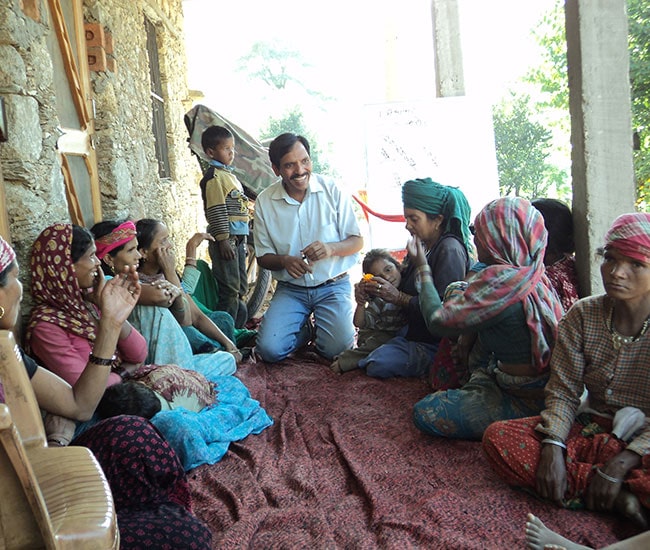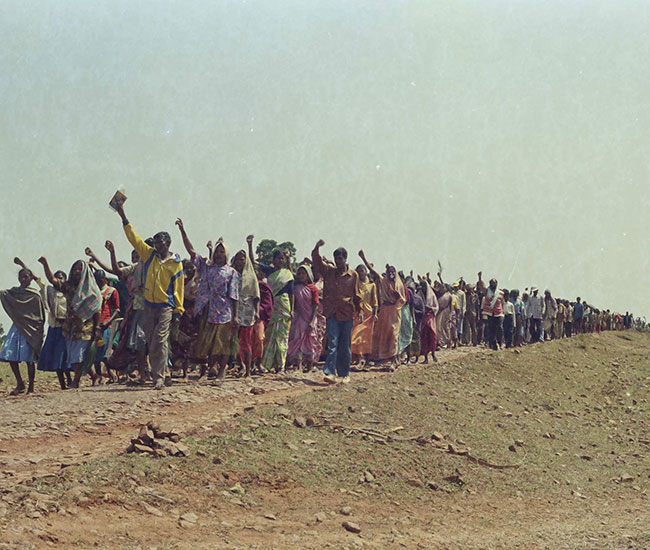
Bundelkhand Mazdoor Kisan Shakti Sangathan
Background
Ruled by the Chandelas until the sixteenth century, the area of Bundelkhand area comprises the districts of Uttar Pradesh and Madhya Pradesh — Damoh, Sagar, Chhattarpur, Panna, Tikamgarh, part of Satna, and right up to Gwalior, from Madhya Pradesh; Jalaun, Jhansi, Hamirpur, Mahoba, Lalitpur and Banda districts of Uttar Pradesh. Damoh is well-known for the legend of Rani Durgawati who fought bravely against the Mughals. Today, the district is also known for its sanctuaries like Nauradehi Sanctuary in Tendukheda block and Rani Durgawati Sanctuary in Jabera block.
Damoh is largely inhabited by tribal groups like the Gonds, Lodhis, Karpetis, and other communities like the Dalits, Rajputs, Kurmis, Thakurs and Marwaris. The economy here is based on agriculture. Dalits do not possess much land and earn their living as labour on the fields. Traditionally, Dalits were mainly involved in the tanning of leather and in manual scavenging, but opportunities are slowly opening up which help them achieve a level of occupational mobility.
With very little or no arable land, the Dalits and OBCs often migrate to neighbouring areas to work as agricultural labourers, or to larger cities for menial work. The society is largely feudal in nature and untouchability is widely practised. The secondary status of women in this region (the purdah system is still in practice) has also been one of the reasons for the absence of a culture of resistance.
Based in the town of Tejgarh in Damoh, the Bundelkhand Mazdoor Kisan Shakti Sangathan (BMKSS) was formed in July 2007, with an aim towards ensuring the ownership of forest land by tribals, dalits and people from other backward castes, as per the Forest Rights Act of 2006. The sangathan was earlier supported by the Grameen Vikas Samiti, but owing to differences in principles, it became a separate entity in 2007. Education and the public distribution system (PDS) are also among the core areas of the sangathan’s work. Currently, it has taken a strong stance against alignment with any political party, as it sees itself as a strong opposition to the administration, no matter which party is in power.
Led by Lakhan Singh, the sangathan today comprises 20 core members. It works in 150 villages, based on different issues pertaining to those places. Due to the patriarchal society, not too many women have been part of the sangathan. However, the sangathan functions through a democratic set-up – there is no hierarchy and since each person represents a certain area of work based on his residence, it is observed that each of them have an equal say in the decision-making processes of the sangathan. (Team)
Due to the patriarchal structure of the society, the sangathan has been facing a lot of difficulties to enable women to be involved in the process of a Jan Sangathan or even in the gram sabhas. The Women’s Literacy Project had been of some help where at least they would meet often and talk on certain issues.
Tribals account for 80 per cent of the sangathan’s work focus. Due to migration, new rituals and practices are deeply entrenched into the tribal lives, such that they today consider themselves as Hindus today. While the FRA might have given the tribals a hope of claiming their ownership on certain patches of forest land, its non-implementation has been one of the key concerns of BMKSS. Instead of being a tool to ensure people’s rights over the land, the FRA has instead become a bane for the people. However, until recently, the sangathan has facilitated the submission of 10,566 claims for land holdings to be legalised under FRA (Towards Implementing FRA). The nexus between the Forest Department and timber merchants further ensured the subjugation of the tribals, and this has been the common link between most villages in Tendukheda block where BMKSS works. Additionally, the proposed cheetah project which has led to the creation of two sanctuaries, will displace 130 villages. The signs of coercion are already visible. The political platform is being shared by people from different castes and tribes, but this still doesn’t trickle down to practising it on a real basis. However, Lakhan feels that one of the major victories has been the formation of the sangathan itself with people from different castes, sharing the same platform and working together.
The sangathan often organises day-long meetings with people and local activists where various issues are discussed, on oppression, environment, development. It is towards an effort to get people to start thinking and talking, and get the people to conduct surveys in their village, about income, livelihood, investments, expenditures, etc. One such meeting was done towards an effort to get people to understand the tax amount that they would pay to the government and the obligations of the government. “When we began to show them the calculations of the tax money being generated from every village, people had the question in mind whether they ran the government, or whether the government was ruling their lives. We told them this was the basic crux of asking questions to anybody contesting the elections and canvassing for votes. People realised that they ought to ask questions about the whereabouts of their money, and what percentage of that amount was used up for the developmental works within the village. People never think on these lines and they feel that the government is indeed doing a lot: it launches new schemes all the time to eradicate poverty, helping people build their homes, give food to children in school, etc. Hence that particular meeting was a success in many ways – getting more people to believe in our efforts and to learn to look at the government objectively,” says Lakhan.
The sangathan had started a theatre company and in 2006, some of them had undergone training in Kolkata to master the skill. The strategy of the theatre company during its street plays has been to ask the audience a lot of questions persistently, and then provoke people enough so that they indeed begin to seek answers within themselves.
The severe winter of 2010, which was last seen by the people of Bundelkhand 30 years ago, had destroyed most crops, especially the plantations of arhar daal. In 2008, the sangathan had made an attempt to collect the local seeds of various plants which would not have been cross bred or cultivated with the help of chemicals. The seeds were distributed to people to plant them, but the yield was just 20 per cent. This was just a mere experiment, but it failed. “We saw that in earlier times, only manure was used as fertiliser. People had more cattle then, and hence there would be enough manure,” says Lakhan. But attempts are on to revive organic farming.
Amongst the sangathan members, in possession is 4 acres of land which they intend to use as an office and congregation space, even for trainings. “We want to create a space to be able to accommodate at least 100 people at one time. If we build it on the principles of ‘Shram daan’, getting the raw materials for the construction will alone cost us Rs 5 lakh,” says Lakhan.
Stories
Team
Karyakartas who have been assigned with certain work draw up a rough plan of the work, and then based on the suggestions from the sangathan, the plans are then made concrete. Every karyakarta maintains a monthly diary of work done, planned, etc. On the 10th of every month, every karyakarta then produces a brief monthly report. A more consolidated report is then prepared every quarter, which includes details of work done, major incidents, achievements in getting people their dues from work done through NREGA, results of complaints made and redressed, etc. Letters sent to various people in the administration are also followed-up with the concerned officials, as also keeping a track of developments in the area via newspaper clippings, etc.
Women’s Literacy Project
BMKSS conducted the women’s literacy programme in 10 schools in 10 villages. There were 6 female karyakartas who were managing the programme, along with four men. Two of the women from among the students had developed the confidence to become aanganwadi karyakartas.
Initially about 25 women had registered in each of the schools, but the number would dwindle to 8-10 women as regular students. Dalit and tribal women participated in the programme.
When the sangathan would approach the women asking them to join in the classes, they would refute its need as they did not see education as impacting their lives in any way. “Motivation was not easy. All their hopes have long died. It is an uphill task getting them to want to live again, with new vigour. Women wake up early in the morning to go to the forests to fetch firewood. Then they head to the market to sell it. Then will then return to cook food and after a quick meal, they will head to the forest again, or to their farm, depending on the priority of their work. When they return in the evening, they have to begin making meals and taking care of their children. After long hours of work, where would they have the energy to sit and study? Girls from 10 years to women up to 60 years walk miles with logs of wood on their head. The men won’t help – at best, they’d just bring the firewood home from the forests. But he won’t walk miles to the market to sell the firewood – it will be a slap on his reputation if he did that. In a situation where they have to worry each day about food, they’d rather slog at work and earn some food for dinner. What would education bring them? So the challenge was to transcend those obvious barriers,” adds Beerendra Singh, Lakhan’s childhood friend and a key karyakarta of the sangathan.
The only benefit, as Lakhan observes, was that women were beginning to come forward and got to know more about the sangathan and its scope of work.
Most of the classes took place during the evening, but at some centres they were also conducted in the day time. While women were always hard-pressed for time because they had to also take care of their fields, most women did not have vast acres of arable land to work on, which would have consumed their entire day on the fields. “Most women were inquisitive to learn new things and hence they would come. The programme should have ideally been carried for a year, which would have shown some results to be able to deduce its result. Often, since the people have several issues that are revolving in their head, they are not able to grasp all the information disseminated to them. It would be wrong to assume that they would be able to concentrate during the classes, and hence it requires a lot of patience,” explains Beerendra.
One day of the week was assigned as a cultural day where the teaching was through local music. Mondays would be days when the women would sing bhajans. So during that time when the aura was already musical, some songs developed through the sangathan were also sung.
Men were of mixed views about the literacy programme. While some men would encourage the women to study, others would lock the women in their homes! Or when women who return home from the classes, their husbands wouldn’t let them in. They would tell them, ‘Why have you returned? Go back and study again!’
The sangathan saw the literacy programme as an important tool to get the womenfolk together under a single platform. “While they may be taught the alphabet, they could also talk about their problems and take help in getting them addressed. That was also possible to quite an extent but we couldn’t see the desired impact. Six months is anyway too short a period to expect suppressed women to start talking. So when the programme ended, the women too lost interest in coming to these schools, while the karyakartas too lost their interest in teaching,” Lakhan says.
The other factor why the programme wasn’t too successful was because it was not in sync with the principles of the sangathan. There were issues about funds and the stipends for the karyakartas. “Besides, we had to show the impact, which isn’t possible through a programme of just 6 months. It was defeating the motive of the sangathan, which is about equality, fighting corruption, fighting the reign of feudalism, ensuring that government schemes are implemented well. But we were not able to further the sangathan’s motives through this programme. There were issues about the syllabus too – the sangathan wanted stories of success from among the women in their area, like women who had struggled to get proper wages for their labour and were successful in it. But the syllabus was about the alphabet and words formation, which is of no use to the old women who had never been to school. They don’t need knowledge about alphabets or maths – they surely have some wisdom of running their families,” says Lakhan.
It was not a good idea to hire more women for the programme as they only looked at it like a job. “The salary offered was also very low. Why would anyone leave labour or work in their fields for such a job, if they weren’t being compensated well? We should have our own money, our own people, our own motives and agendas, and perhaps our own rules and provisions,” reasons Beerendra.
Towards Implementing FRA
When the FRA was passed, BMKSS had conducted a survey of those eligible for ownership of forest land, in 60 villages of 28 Panchayats in Tendukheda block. They found out that the people had to pay bribes to the Forest Department officials in order to be able to work on those patches of forest land. They either had to pay in cash or kind, by offering some chickens or alcohol, or even to labour for a petty amount.
So the sangathan initiated a movement to get the people to be united in ending the practice of offering bribes. “It was necessary that people be united in not cooperating with the Forest Department officials and their unruly demands. That’s how people then began to work on those lands again. So people developed their confidence that it was indeed possible to lead their lives with dignity by farming on the forest land, and thus challenging the Forest Department. With this view in mind, the sangathan has been furthering its efforts,” says Beerendra.
It was the Forest Department initially that cleared many forests for private projects. Tribals residing in those areas saw the near-barren land and thus thought it to be fit for agriculture, and began to cultivate those fields. People did not see the need to have papers to certify their right over the forests, land and water. But then the Revenue Department, the Forest Department and even the tribals began to fight for the ownership of those lands. BMKSS got people to then file their claims for the land, as per PF 2 forms. The FRA came into existence in 2006 and subsequently more claims were submitted.
The sangathan has hitherto processed the submission of 10,566 claims for land holdings to be legalised under FRA. Of this number, just 561 claims have been approved (pattas have been given). Several campaigns and mass mobilisations have thus been initiated with letters sent to the Chief Minister, asking for reasons and processes by which the claims are rejected. There have been several cases where the people have confronted the Forest Department head-on. In one village, 29 people including two women have been fined for putting up a strong vocal front before the Forest Department. There have been other instances where large tractors have been brought to destroy the standing crops on the farms, and cases of forest land encroachment have been slapped against them. There also cases where the Forest Department insists that people have been residing in the forest patches of land only after 2006 and hence their claim over the land is illegal. Cases have been registered against women for picking firewood.
In the face of oppression of this nature, it is quite possible that people whose claims have been rejected might give up their land holding. The sangathan’s efforts have been to offer people strength to continue to live on the land and fight for their rights over it, and not bow down to the pressures of the administration. Following the rejection of majority of the claims, the sangathan took up the case of rejected claims of five villages in the court, as the Forest Department had begun bringing in bulldozers to raze the land. People are now witnessing their standing crops being razed, and hence the anger converts into a sense of unity to fight the unresponsive administration.


